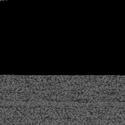|
>>
|
No. 402
File
134186581068.png
- (7.62KB
, 256x256
, page.png
)
Thumbnail displayed, click image for full size.

>>398
Thumbnails would be a moot point anyway because 4chan uses jpeg compression for all thumbnails, thus compromising the integrity of the data even if the file dimensions are within the limits of a thumbnail.
>>399
Post processing of images is generally not done on chans due to the excessive burden which is placed on the server CPU. Any post processing which might be done to save space would most likely consist of stripping metadata. However, since the data has literally been transformed into a visual representation, the data is safe from tampering.
In the most basic form, transfer mode, it might work something like this:
*Grayscale bitmap is created (all black/00).
*Must be a square of 2 with total pixel area exceeding size of file to be encoded.
>2x2=4
>4x4=16
>8x8=64
>16x16=256
>32x32=1024
>64x64=4096
>128x128=16384
>256x256=65536
*Bitmap is opened in hex editor.
*Hex data is pasted at the first pixel. (This can be identified by placing a white pixel at the top left and bottom left of the bitmap before saving. The first pixel will then be hex FF.)
*Locate the 'last' pixel. (The second FF near end of file.)
This is where the rebuild parameters are stored.
The rebuild parameters are a 17 byte string containing instructions for recreating the original bitmap file so the hex data can be extracted. (It could be shorter than 17 if we came up with a logical system rather than a human-identifiable one.)
The FF byte is changed to F0.
F0(format) is followed by 1 byte to represent the original file format. There are 2 formats which can be used to store the data:
>b3 (uncompressed bitmap)
>1f (uncompressed tiff)
Bitmap is preferred because the file structure is arranged so that when the data is converted to png, the rebuild parameters will be the first 17 pixels at the top left corner.
Next...
BD (bit depth) is followed by a 2 byte code
Byte 1 (color depth):
>01 (grayscale)
>02 (grayscale+alpha)
could be used to provide more storage without creating excessively large bitmaps
>03 (RGB)
>04 (RGB+alpha) hypothetically
Byte 2 (bits per pixel)
>08 (8bpp- standard)
>16 (16bpp- not supported by most image programs)
Could try splitting bytes between the gray and alpha channels, not sure if that would create more compressible redundancy or just complicate things more by doubling the color depth.
After this we have,
DA (data type)
>AC (ascii: text data)
>B1 (binary)
And finally we have the raw data locations. Unfortunately, these offsets assume that all programs will create a (grayscale) bitmap with the same amount of header garbage. I haven't checked into this yet.
DB (data begin) is followed by 4 bytes which refer to the offset for the start of the data portion.
DE (data end) is followed by 4 bytes designating the offset for the end of the data.
At first I thought I'd just write this in ascii at the EoF, but then I realized that would leave variable-length strings to be identified, which makes things more complicated and diminishes the number of like pixels.
The attached image is this web page encoded using this method.
|